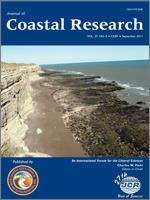The cliffs along the northern Patagonian coast of Punta Bermeja, Río Negro, Argentina, rise more than 40 m above the sea. These cuts on the Río Negro Formation date back to the Early Miocene-Late Pliocene periods. Along the top-left of the photograph, a hanging stable dunefield is emplaced and integrated by Holocene parabolic dunes. Seaward, an extended wave-cut platform is currently exposed during a low tide. Three sections compound this Río Negro Formation. The lower section is composed of sandstones and mudstones deposited in a mainly aeolian paleoenvironment. The middle unconformity section overlies the lower section near the base of the cliffs and consists mostly of marine deposits. The upper sectionis made up of fine to medium grained sandstones and mudstones deposited in an aeolian depositional environment similar to that of the lower section. Wave-cut platforms are emplaced over the lower section and dissectedby numerous sub-verticaljoints. Higher surface levels on the platforms represent paleolakes that were deposited in slacks between dunes during the Late Miocene. Punta Bermeja, which is a Provincial Faunistic Reserve of the Río Negro province, covers an area of 200 ha. At present, it houses one of the world's largest continental reserves of sea lions (Otaria flavescens). Currently, the total population of O. flavescens along the coast of Argentina is estimated at around 100,000 individuals. Sea lion colonies are more commonly found along rocky platforms rather than sand, gravel or pebble beaches, and are usually established around tidepools on these rocky platforms.Photograph taken on December 2010 by Silvia C. Marcomini, Laboratorio de Geología Costera, Geology Department, Buenos Aires University, Buenos Aires, Argentina. scm@gl.fcen.uba.ar






